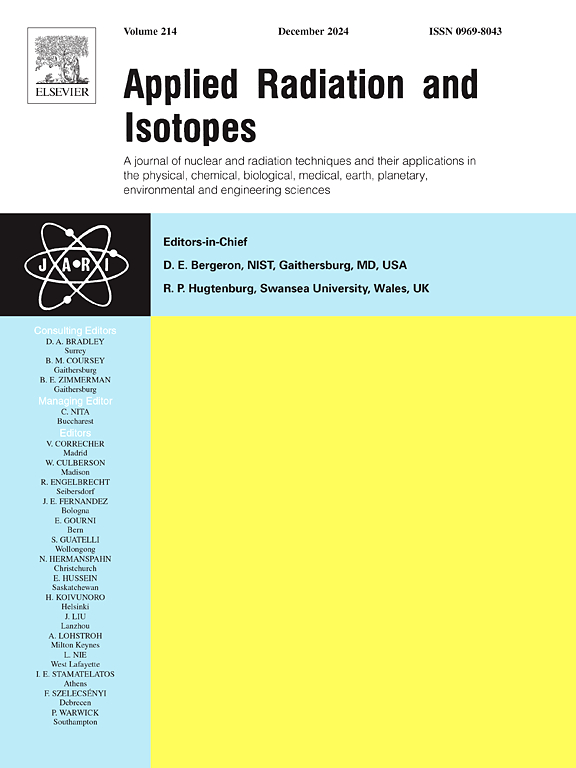Radiolabeling, quality control, and in vitro cell culture studies of [99mTc]Tc-tamoxifen citrate for estrogen receptor-positive breast cancer imaging
IF 1.8
3区 工程技术
Q3 CHEMISTRY, INORGANIC & NUCLEAR
引用次数: 0
Abstract
Background
Early and accurate imaging of estrogen receptor-positive (ER+) breast cancer remains an unmet need in nuclear medicine. Tamoxifen, a selective estrogen receptor modulator, offers a molecular targeting strategy, yet previous radiolabeling approaches often required elevated temperatures or chelating agents.
Purpose
This study aimed to develop and evaluate a simple, chelator-free radiolabeling method for tamoxifen citrate (TC) with technetium-99m ([99mTc]Tc) under mild conditions, without requiring purification, and to assess its physicochemical stability and selective uptake in breast cancer cells.
Methods
[99mTc]Tc-TC was synthesized using stannous chloride as a reducing agent at room temperature. Radiochemical purity was assessed by radio thin-layer chromatography (RTLC) and radioelectrophoresis. Stability was examined in saline and cell culture media. Cellular uptake was evaluated in ER+ (MCF-7) and ER- (MCF-10A) cell lines. A theoretical coordination model of [99mTc]Tc-TC was also proposed.
Results
The most stable [99mTc]Tc-TC complex was formed using 0.01 mg of stannous chloride as the reducing agent, 37 MBq of activity at pH 7.4, and a 20 min incubation time. The radiolabeled complex showed >97 % radiochemical purity and remained stable for 6 h in saline and 2 h in cell medium. Cellular uptake in MCF-7 cells was approximately 72–77 %, more than double that in MCF-10A cells (around 30 %), demonstrating ER+ selectivity. Radioelectrophoresis confirmed a distinct migration profile from [99mTc]Tc-citrate, supporting the formation of a [99mTc]Tc-TC complex.
Conclusions
[99mTc]Tc-TC was successfully synthesized via a simple room-temperature labeling strategy, showing high stability and ER-specific cell uptake. Although in vivo validation is planned for future studies, this formulation holds promise as a receptor-targeted radiopharmaceutical for breast cancer imaging.

[99mTc] tc -柠檬酸他莫昔芬用于雌激素受体阳性乳腺癌成像的放射标记、质量控制和体外细胞培养研究
背景雌激素受体阳性(ER+)乳腺癌的快速准确成像在核医学中仍然是一个未满足的需求。他莫昔芬是一种选择性雌激素受体调节剂,提供了一种分子靶向策略,然而以前的放射性标记方法通常需要高温或螯合剂。目的建立一种简单、无螯合剂、不需要纯化的锝-99m ([99mTc] TC)放射标记枸橼酸他莫昔芬(TC)的方法,并评价其在乳腺癌细胞中的物理化学稳定性和选择性吸收。方法以氯化亚锡为还原剂,在室温下合成[99mTc]Tc-TC。采用放射性薄层色谱(RTLC)和放射电泳法测定放射化学纯度。在生理盐水和细胞培养基中检测稳定性。在ER+ (MCF-7)和ER- (MCF-10A)细胞系中评估细胞摄取。提出了[99mTc]Tc-TC的理论配位模型。结果以0.01 mg氯化亚锡为还原剂,pH值为7.4,孵育时间为20 min,活性为37 MBq,形成最稳定的[99mTc]Tc-TC配合物。放射标记的复合物显示97%的放射化学纯度,在生理盐水和细胞培养基中分别保持6小时和2小时的稳定。MCF-7细胞的细胞摄取约为72 - 77%,是MCF-10A细胞(约30%)的两倍多,显示出ER+选择性。放射电泳证实了[99mTc] tc -柠檬酸盐的明显迁移特征,支持[99mTc]Tc-TC复合物的形成。结论通过简单的室温标记策略成功合成了[99mTc]Tc-TC,具有高稳定性和er特异性的细胞摄取。虽然在体内验证计划为未来的研究,该配方有望作为受体靶向放射性药物乳腺癌成像。
本文章由计算机程序翻译,如有差异,请以英文原文为准。
求助全文
约1分钟内获得全文
求助全文
来源期刊

Applied Radiation and Isotopes
工程技术-核科学技术
CiteScore
3.00
自引率
12.50%
发文量
406
审稿时长
13.5 months
期刊介绍:
Applied Radiation and Isotopes provides a high quality medium for the publication of substantial, original and scientific and technological papers on the development and peaceful application of nuclear, radiation and radionuclide techniques in chemistry, physics, biochemistry, biology, medicine, security, engineering and in the earth, planetary and environmental sciences, all including dosimetry. Nuclear techniques are defined in the broadest sense and both experimental and theoretical papers are welcome. They include the development and use of α- and β-particles, X-rays and γ-rays, neutrons and other nuclear particles and radiations from all sources, including radionuclides, synchrotron sources, cyclotrons and reactors and from the natural environment.
The journal aims to publish papers with significance to an international audience, containing substantial novelty and scientific impact. The Editors reserve the rights to reject, with or without external review, papers that do not meet these criteria.
Papers dealing with radiation processing, i.e., where radiation is used to bring about a biological, chemical or physical change in a material, should be directed to our sister journal Radiation Physics and Chemistry.
 求助内容:
求助内容: 应助结果提醒方式:
应助结果提醒方式:


